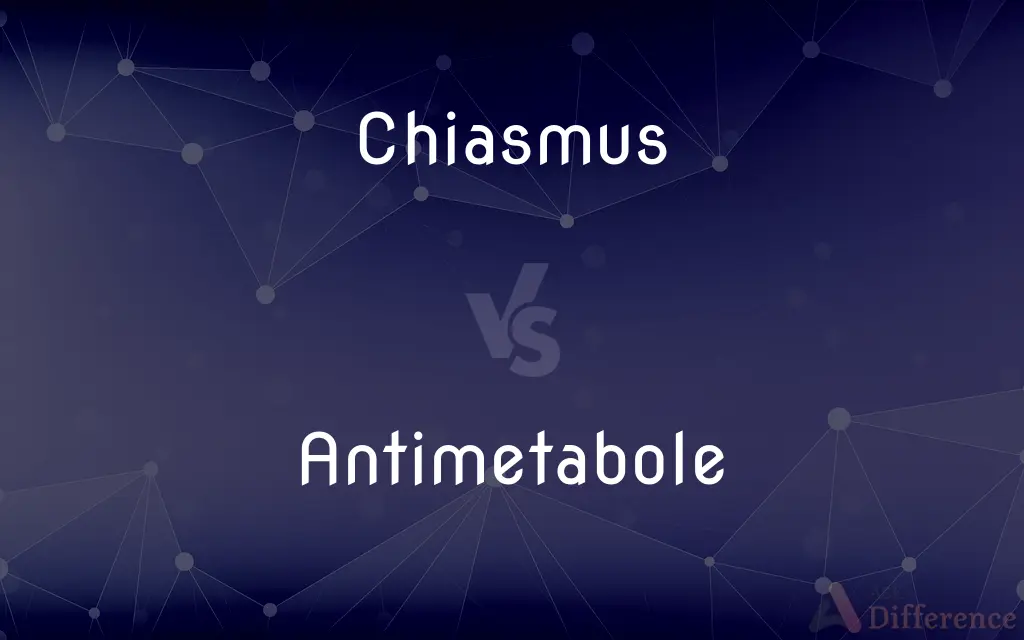Chiasmus vs. Antimetabole — What's the Difference?
By Fiza Rafique & Maham Liaqat — Updated on April 15, 2024
Chiasmus is a rhetorical device involving the reversal of grammatical structures in successive phrases or clauses, while antimetabole specifically repeats the words, in reverse order, to sharpen a contrast.

Difference Between Chiasmus and Antimetabole
Table of Contents
ADVERTISEMENT
Key Differences
Chiasmus involves the mirroring of grammatical structures or concepts in a sentence, creating an artistic effect and emphasizing parallels or contrasts. Whereas, antimetabole is a form of chiasmus that not only reverses the structure but also repeats the exact words in a flipped order to make a point more emphatic or memorable.
In literature, chiasmus might not necessarily involve a precise repetition of words but focuses more on the reversal of a structure, such as "He went to the country, to the town went she." On the other hand, antimetabole requires a precise repetition of words, as in John F. Kennedy's famous saying, "Ask not what your country can do for you ask what you can do for your country."
Chiasmus can be used to enhance the beauty of the language, adding a lyrical quality or poignancy to the expression, as it relies more on the symmetry of the structure. Whereas antimetabole, by repeating words, often serves to highlight a contradiction or a deeply contrasting idea, making the statement not only poetic but also logically compelling.
The effectiveness of chiasmus lies in its ability to make text more memorable due to its unusual structure, appealing to the reader’s sense of form and balance. Whereas antimetabole's strength is in reinforcing a point through repetition, making the phrase stick in the mind due to both its form and the repetition of terms.
While chiasmus can be seen in both ancient and modern texts and is often used to convey deep emotions or complex ideas subtly, antimetabole is particularly favored in speeches and persuasive writing because it is straightforward and impactful, driving home a point with clarity and force.
ADVERTISEMENT
Comparison Chart
Definition
Reversal of grammatical structures in phrases
Reversal of words in phrases, with exact repetition
Key Characteristic
Structural mirroring
Word repetition and structural mirroring
Focus
Artistic, lyrical quality
Logical emphasis and memorability
Examples
"He went to the country, to the town went she."
"Ask not what your country can do for you..."
Use
Enhances beauty, adds symmetry
Sharpens contrast, reinforces points
Compare with Definitions
Chiasmus
A rhetorical device in which two or more clauses are balanced against each other by reversal of their structures.
She has all my love; my heart belongs to her.
Antimetabole
Effective in speeches and persuasive writing for emphasis.
If you fail to plan, you plan to fail.
Chiasmus
Often utilized to emphasize a reflection or balance.
Gold is cold, and life is old.
Antimetabole
A figure of speech involving the repetition of words in successive clauses in reverse grammatical order.
Eat to live, not live to eat.
Chiasmus
Used to impart a poetic structure to text, enhancing its appeal.
Never let a Fool Kiss You or a Kiss Fool You.
Antimetabole
Emphasizes contrasts or deep contradictions.
It’s not the men in my life, it’s the life in my men.
Chiasmus
Can involve reversal of ideas without exact word repetition.
Good men don't need rules; today is not the day to find out why I have so many.
Antimetabole
Makes arguments memorable by repeating and reversing words.
You can take the boy out of the country, but you can't take the country out of the boy.
Chiasmus
Adds lyrical quality or emotional depth to writing.
Poetry is the record of the best and happiest moments of the happiest and best minds.
Antimetabole
Often used to highlight logical contradictions or ironies.
I know what I like, and I like what I know.
Chiasmus
In rhetoric, chiasmus ( kahy-AZ-muhs) or, less commonly, chiasm (Latin term from Greek χίασμα, "crossing", from the Greek χιάζω, chiázō, "to shape like the letter Χ"), is a "reversal of grammatical structures in successive phrases or clauses – but no repetition of words".A similar device, antimetabole, also involves a reversal of grammatical structures in successive phrases or clauses, but unlike chiasmus, presents a repetition of words in an A-B-B-A configuration.
Antimetabole
In rhetoric, antimetabole ( AN-ti-mə-TAB-ə-lee) is the repetition of words in successive clauses, but in transposed order; for example, "I know what I like, and I like what I know". It is related to, and sometimes considered a special case of, chiasmus.
Chiasmus
A rhetorical or literary figure in which words, grammatical constructions, or concepts are repeated in reverse order.
Antimetabole
(rhetoric) The technique of reversal, where accentuated by reversal of words, actions or grammatical structure.
Chiasmus
A rhetorical inversion of the second of two parallel structures, as in "Each throat / Was parched, and glazed each eye" (Samuel Taylor Coleridge).
Antimetabole
A figure in which the same words or ideas are repeated in transposed order.
Chiasmus
(rhetoric) An inversion of the relationship between the elements of phrases.
Chiasmus
An inversion of the order of words or phrases, when repeated or subsequently referred to in a sentence
If e'er to bless thy sonsMy voice or hands deny,These hands let useful skill forsake,This voice in silence die.
Chiasmus
Inversion in the second of two parallel phrases
Common Curiosities
What is the primary difference between chiasmus and antimetabole?
Chiasmus involves reversing grammatical structures, while antimetabole includes exact word repetition in reverse order.
How does antimetabole strengthen an argument?
Antimetabole makes an argument more memorable and emphasizes logical structure through word repetition.
Are chiasmus and antimetabole only used in English?
No, these rhetorical devices are used in various languages to enhance literary and speech effectiveness.
Can chiasmus be unintentional?
While it can occur unintentionally, it is usually used with a purposeful artistic intention in writing.
How does antimetabole affect reader or listener perception?
It often makes the message stand out due to its structured repetition, helping in better retention.
Can chiasmus include antimetabole?
Yes, antimetabole is a specific type of chiasmus that includes exact word repetition.
What is the effect of antimetabole in speeches?
Antimetabole can make speeches more impactful and memorable due to the clarity and emphasis it provides.
What are some famous examples of chiasmus and antimetabole?
Famous examples include JFK's inaugural address for antimetabole and various poetic lines for chiasmus, like "Love as if you would one day hate, and hate as if you would one day love."
Why use chiasmus in writing?
Chiasmus can enhance the poetic or emotional impact of writing by introducing a mirrored structure.
How can one identify chiasmus in text?
Look for sentences where the structure is mirrored, even if the exact words are not repeated.
Share Your Discovery

Previous Comparison
Content vs. Expression
Next Comparison
Exemplar vs. ExemplaryAuthor Spotlight
Written by
Fiza RafiqueFiza Rafique is a skilled content writer at AskDifference.com, where she meticulously refines and enhances written pieces. Drawing from her vast editorial expertise, Fiza ensures clarity, accuracy, and precision in every article. Passionate about language, she continually seeks to elevate the quality of content for readers worldwide.
Co-written by
Maham Liaqat















































